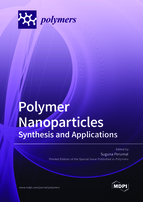Polymer Nanoparticles: Synthesis and Applications
A special issue of Polymers (ISSN 2073-4360). This special issue belongs to the section "Polymer Composites and Nanocomposites".
Deadline for manuscript submissions: closed (25 October 2022) | Viewed by 43702
Special Issue Editor
Interests: synthesis of polymers; preparation of polymer–graphene composites; heavy metal ion adsorption using hydrogels; nanoparticle synthesis
Special Issues, Collections and Topics in MDPI journals
Special Issue Information
Dear Colleagues,
Polymer nanoparticles have been extensively studied recently because of their novel properties resulting from their small size. The advantages of polymer nanoparticles are their ability to tailor the size, chemical composition, and molecular weight of the polymer chain. These polymer nanoparticles are biocompatible and have a broad-structure variety, such as vesicles and micelles, which are the result of the self-assembly of polymers.
This Special Issue will explore the evolution and enhancement of polymer nanoparticles and their applications. This issue will enable readers to optimize the design of polymer nanoparticles and give rise to a greater application of polymer nanoparticles. Articles, reviews, and communications are welcome.
The topic includes:
- Synthesis of polymers–copolymers, block copolymers, grafted polymers, etc.;
- Preparation of polymer nanoparticles;
- Characterization of polymers and polymer nanoparticles;
- Detailed study of polymeric nanoparticles;
- Applications of polymeric nanoparticles in various fields.
Dr. Suguna Perumal
Guest Editor
Manuscript Submission Information
Manuscripts should be submitted online at www.mdpi.com by registering and logging in to this website. Once you are registered, click here to go to the submission form. Manuscripts can be submitted until the deadline. All submissions that pass pre-check are peer-reviewed. Accepted papers will be published continuously in the journal (as soon as accepted) and will be listed together on the special issue website. Research articles, review articles as well as short communications are invited. For planned papers, a title and short abstract (about 100 words) can be sent to the Editorial Office for announcement on this website.
Submitted manuscripts should not have been published previously, nor be under consideration for publication elsewhere (except conference proceedings papers). All manuscripts are thoroughly refereed through a single-blind peer-review process. A guide for authors and other relevant information for submission of manuscripts is available on the Instructions for Authors page. Polymers is an international peer-reviewed open access semimonthly journal published by MDPI.
Please visit the Instructions for Authors page before submitting a manuscript. The Article Processing Charge (APC) for publication in this open access journal is 2700 CHF (Swiss Francs). Submitted papers should be well formatted and use good English. Authors may use MDPI's English editing service prior to publication or during author revisions.
Keywords
- Polymers
- Polymer nanoparticles
- Semiconducting polymer nanoparticles
- Biodegradable polymer
- Advancement in polymer nanoparticles
- Polymers in nanotechnology
- Properties
- Drug delivery
- Controlled release
- Therapy







